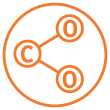Visibility-reducing particles
Key Finding
While the past 2 decades have seen a downward trend in the number of days with reduced visibility (defined as a visual distance less than 20km) throughout Queensland, there were more than 10 reduced visibility days in all Queensland regions in 2000, 2001 and 2009 due to dry conditions and widespread bushfires. In addition, due to localised bushfires, South East Queensland recorded more days with reduced visibility in 2004, 2012 and 2019 as well, while Gladstone recorded more days with reduced visibility in 2011, 2015 and 2017 to 2019.
A build-up of fine airborne particles can reduce how far we can see through the air. The Environmental Protection (Air) Policy 2019 (Air EPP) provides a visual amenity objective of 20km. This means it should be possible on a fine day to see an object 20km away.
Reductions in visibility are largely attributable to burning activities such as combustion in motor vehicles and industry, bushfires and the fine particles resulting from photochemical smog formation, and windblown dust. While bushfires and dust storms can also affect the Mackay and Ayr (Burdekin) regions, smoke from cane burning in the Burdekin and from cane trash burning in the Mackay region also can reduce visibility in these regions.
Overall, fewer days have exceeded the Air EPP goal since 2000.
- Since 2002, most regions have experienced 10 or fewer days of low visibility each year.
- All Queensland regions experienced a higher number of days of exceedance in 2000, 2001 and 2009 due to very dry conditions and widespread bushfires.
- South East Queensland also experienced more days of poor visibility in 2004, 2012 and 2019 due to widespread bushfires in the region in these years.
- Gladstone experienced additional days of poor visibility in 2011, 2015 and 2017 to 2019 due to widespread bushfires in the region in these years.
- More poor visibility days were experienced in Mackay in 2000 and 2001 due to more extensive cane burning in the Pioneer Valley west of Mackay in these years. Since then there has been a gradual progression to almost 100% green cane harvesting, resulting in fewer reduced visibility days in Mackay.
- Ayr experienced more than 10 days of poor visibility in 2011 and 2014 due to increased rates of sugar cane burning prior to harvesting in these years.
More information:
Relevant Sustainable Development Goals’ targets
Number of days when the 1-hour visibility-reducing particle concentrations exceed the Air EPP goal
- Chart
- Table
| Airshed | South East Queensland | Gladstone | Mackay | Ayr | Townsville |
|---|---|---|---|---|---|
| 2000 | 33 | 17 | 34 | ||
| 2001 | 12 | 19 | 13 | ||
| 2002 | 5 | 10 | 7 | ||
| 2003 | 9 | 2 | 5 | ||
| 2004 | 13 | 4 | 6 | ||
| 2005 | 5 | 3 | 5 | ||
| 2006 | 4 | 4 | 2 | ||
| 2007 | 9 | 2 | 2 | ||
| 2008 | 2 | 2 | 5 | ||
| 2009 | 12 | 27 | 11 | ||
| 2010 | 4 | 1 | 5 | ||
| 2011 | 4 | 16 | 9 | 12 | |
| 2012 | 12 | 4 | 1 | 2 | |
| 2013 | 7 | 0 | 8 | 8 | |
| 2014 | 7 | 4 | 3 | 11 | |
| 2015 | 4 | 21 | 2 | 9 | |
| 2016 | 6 | 6 | 2 | ||
| 2017 | 7 | 15 | 1 | 0 | |
| 2018 | 7 | 32 | 3 | 4 | |
| 2019 | 21 | 18 | 0 | 1 |
Download data from Queensland Government Open Data Portal
Metadata
Trends in number of exceedances of Air Environmental Protection Policy (EPP) goal for visibility-reducing particles by airshed for 2000–2019.








